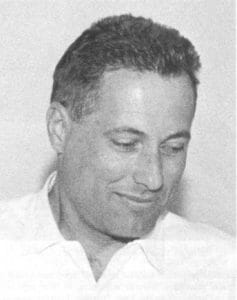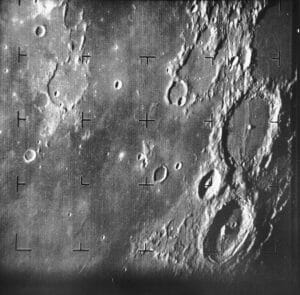Growing up in Claremont, Calif., Burke was fortunate to attend the Webb School, a boarding and day high school in Claremont with a “legacy of putting honor and moral courage above all else.” From there he attended the California Institute of Technology for an mechanical engineering degree in 1945, served as a U.S. Naval aviator, and then returned to Caltech for his Masters in Aeronautics. When he graduated in 1949, the Jet Propulsion Laboratory, which at that time was run by Caltech for the U.S. Army, was taken over by NASA; Burke was tapped to be deputy of its Lunar Program. He was to stay in that position when, in 1959, he was also appointed as head of the Ranger program, which was meant to obtain the first close-up photos of the moon. No human mission to the moon had been seriously proposed at that point, but shortly after Russia’s Sputnik launch of the first artificial Earth satellite, JPL Director William H. Pickering wanted the United States to meet the Russian space challenge by sending a spacecraft to soft-land a scientific instrument on the moon — in addition to first putting up the first U.S. satellite, Explorer I. The Pioneer program was also attempting to reach the moon, but its attempts were unsuccessful.

Ranger was designed to operate in three “blocks” (or phases). “With a bent for the theoretical,” NASA’s History Office explained, “Burke combined a swift grasp of [the] complex system and integrate the most promising mechanical and electrical features to achieve technical objectives.” His was a team of three — including Burke. They “solved the major guidance problem, velocity control, associated with solid-propellant ballistic missiles. Soon recognized as one of [JPL’s] most perceptive research engineers [and] [l]ooking younger than his 35 years, often wearing an old naval aviator’s jacket astride his bright green motorcycle, Burke could easily be mistaken for a Caltech student instead of JPL’s manager of Project Ranger. Articulate, with a quick smile and hearty laugh, he galvanized those who worked with or for him by force of logic, persuasion, and sheer enthusiasm.”
Each block had different mission objectives and progressively more advanced system design, with multiple launches in each block to maximize the engineering experience and scientific value of each mission, and to assure at least one successful flight in each Block. One of the first things Burke had to work on: the Pioneer probes were spin-stabilized, but that wouldn’t work well for spacecraft that needed to take clear photos — and powered by primitive solar panels. Sixteen Agena rockets were requested for the program, but NASA cut it to nine. Considering the difficulties of rocketry and spacecraft design in the early 60s, they barely made it:
- Ranger 1 (launched August 1961) was supposed to go into Earth orbit to test its systems, but a rocket malfunction left it in such a low orbit, the flailing spacecraft burned up in the atmosphere a week later. Meanwhile, Russia had upped the ante in the space race with the launch of a human, Yuri Gagarin, on a quick one-orbit trip in April.
- Ranger 2 (November 1961) was supposed to be in a high enough Earth orbit to pass close to the moon, but it too failed and burned up in the atmosphere the day after launch.
- Ranger 3 (January 1962) was the first Block II launch, designed to take numerous photos of the moon as it approached on a suicide mission: it was to impact the moon …but it missed by 22,000 miles. It had one success: it took the first measurements of interplanetary gamma ray flux.
- Ranger 4 (April 1962) was designed to transmit pictures during descent and to rough-land a capsule carrying a seismometer and other instruments. A computer problem prevented it from performing any operations, and it impacted the Moon’s far side.
- Ranger 5 (October 1962) was another attempt to get to the moon, but a malfunction with the spacecraft’s batteries caused them to drain after about eight hours of flight, leaving Ranger 5 inoperable. The team regrouped, taking more than a year to redesign the spacecraft. One decision: Burke needed more time for engineering work, so the project management responsibility was shifted to Harris Schurmeier, also a former U.S. Navy pilot and Burke’s Caltech classmate.
- Ranger 6 (January 1964) started Block III, and was designed to take photos before it impacted the moon. The good news was, it hit the moon as designed. The bad news was, the power supply for the RCA-built TV camera package short-circuited during booster separation, leaving the system inoperable.

- Ranger 7 (July 1964) was …an absolute success! “In some ways,” NASA’s History Office wrote, “it marked a major milestone in American deep space exploration as the ratio in favor of successes increased dramatically after this point.” It started rapidly taking photos of the moon about 20 minutes prior to impact and transmitted them immediately to JPL’s Deep Space Network for download. Photo number 4,316 was interrupted shortly before it was fully downloaded — the spacecraft crashed into the northern rim of the moon’s Sea of Clouds. Its best photos were a thousand times better than those taken from Earth, and good enough for mission planners to conclude that a safe human landing could be accomplished in the mare regions of the lunar surface, given their relative smoothness.
- Ranger 8 (February 1965) built on 7’s success, sending back 7,138 high-resolution photos of the moon before impacting a few miles from the Sea of Tranquility — the target landing site for Apollo 11.
- Ranger 9 (March 1965) was the final in the program, sending back 5,814 more images from four different cameras. It was the first time the cameras were pointed in the exact direction of travel, which enabled live TV coverage of what the spacecraft was seeing before impact at 1.7 miles per second. (See below for a video that recreates the sequence.)

“Had Burke been more forceful and demanding, perhaps he could have made the early Rangers work,” the NASA History Office concluded. “He did occupy himself considerably with trying to carve out an appropriate area of authority. The cost included having to delegate spacecraft details to the Systems Division, where many of them were attended to improperly. But Burke, youthful and informal, having never even headed a JPL technical division, could not easily make headway against the established chiefs at the Laboratory, not at least without decidedly more support from Pickering. It took the post-Ranger 5 pressures from NASA Headquarters to curtail the autonomy of the technical divisions and to centralize functions to assure quality and reliability in the project.” Also, it noted, “Burke knew the risks, accepted them — and paid the price. But he had the satisfaction of staying on to see Ranger become the success he had always believed it could be.”

As for the program’s legacy, NASA History says, “image enhancement through digital computer processing was a decidedly impressive gift from Ranger to commercial applications. This process removed spurious noise received with Ranger’s picture signal and enhanced contrasts in the photographs of the lunar surface by shifting the mean intensity level and expanding it to cover the full range of the gray scale from black to white. The technique profoundly affected diverse disciplines including astronomy, lunar cartography, medicine, commercial communications, and microspectroscopy. When applied to enhance X-ray photographs, it was selected by Industrial Research Incorporated as the single most important technical innovation of 1967.”
Years later, looking back on Ranger and its ambition to soft-land a science instrument on the moon, Burke said, “We were trying something that was too complicated. Our reach was exceeding our grasp.” Russia’s Luna 9, followed within months by NASA’s Surveyor 1 in 1966, were the first to survive soft-landing on the moon. After Ranger, Burke continued to work on various other flight projects at JPL. He retired in 2001. He was on the faculty of the International Space University, where he continued his interest in the exploration and settlement of the Moon. On the side, Burke was the editor of the Planetary Society’s newsletter, and wrote articles for various publications, including the Encyclopedia Britannica, The Encyclopedia of the Solar System, and the McGraw-Hill Encyclopedia of Science and Technology. James Donahue Burke died August 21, at 97.
